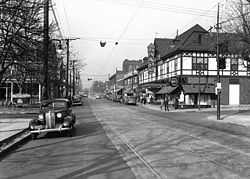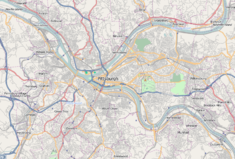- Squirrel Hill (Pittsburgh)
-
"Squirrel Hill" redirects here. For the archaeological site east of Pittsburgh, see Squirrel Hill Site.
Squirrel Hill North 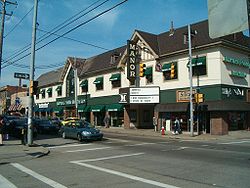
Murray Avenue in Squirrel Hill (2005)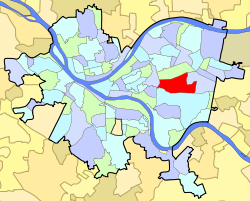
Neighborhood in Pittsburgh, PennsylvaniaPopulation (1990): 11471[1] Population (2000): 10408[1] Area: 1.222 sq mi (3.16 km2)[1] Squirrel Hill South 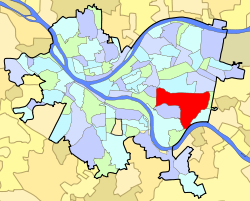
Neighborhood in Pittsburgh, PennsylvaniaPopulation (1990): 14968[1] Population (2000): 14507[1] Area: 2.671 sq mi (6.92 km2)[1] Murray Hill Avenue Historic District City of Pittsburgh Historic District Pittsburgh History and Landmarks Foundation Historic Landmark Murray Avenue in Squirrel Hill (1937)Location: 1010-1201 Murray Hill Avenue (Squirrel Hill), Pittsburgh, Pennsylvania, USA Coordinates: 40°26′59″N 79°55′41″W / 40.449669°N 79.928119°WCoordinates: 40°26′59″N 79°55′41″W / 40.449669°N 79.928119°W City designated: April 3, 2000[2] PHLF designated: 2004[3] Squirrel Hill is a residential neighborhood in the east end of Pittsburgh, Pennsylvania, United States. The city officially divides it into two neighborhoods, Squirrel Hill North and Squirrel Hill South, but it is almost universally treated as a single neighborhood. As of the census of 2000, there were 24,915 people, 10,499 households, and 5,198 families residing there.[1]
Contents
Geography
Squirrel Hill is located at 40°26′17″N 79°55′23″W / 40.438072°N 79.922972°WCoordinates: 40°26′17″N 79°55′23″W / 40.438072°N 79.922972°W. Squirrel Hill has zip codes 15217 and 15232, and is bordered on the west by Oakland and Schenley Park,[4] on the north by Shadyside and Point Breeze, on the east by Frick Park, and on the south by Greenfield and the Monongahela River. Most of Squirrel Hill lies in Pittsburgh's 14th Ward.[5]
History
The growth and development of Squirrel Hill was initially focused on the riverfront along the Monongahela River. The first recorded house was built by a soldier at nearby Fort Pitt, Colonel James Burd, at a place called Summerset on the Monongahela River in 1760. Its first "business district" was the intersection of Brown's Hill Road and Beechwood Boulevard. In 1778, John Turner built his estate of Federal Hill nearby (along what is now Beechwood Boulevard). Squirrel Hill's next house was built by Ambrose Newton in the 1760s. This house is still standing and is located in Schenley Park along Overlook Drive (near the ice skating rink).
The third house was built by Robert Neill around 1787 in what is now Schenley Park. This house still exists and is occasionally open to the public. The Neills owned 262 acres (1.06 km2) of land in the northern section of Schenley Park. In 1795, the Neills moved from this house to a location in what is now Market Square in downtown Pittsburgh, before they died. After they died, the house was handed down to two different people before it was sold to General James O'Hara. O'Hara's granddaughter, Mary Schenley, gave the property to the city of Pittsburgh in 1889. For a time, in the house was rented out by the city to vacationers. However, by 1969, the house was in such poor condition that it was dismantled and rebuilt by the Pittsburgh History and Landmarks Foundation. It still exists and is only open for tours during the Vintage Grand Prix in July.
Around 1820, William "Killymoon" Steward built one of the first tavern/inns in the area. His tavern, located near the intersection of Beechwood and Brown's Hill Road, survived for over 100 years. Slowly, Squirrel Hill became a prosperous and affluent suburb. By the 1860s, the area along Fifth Avenue near Woodland Road had several mansions, including Willow Cottage. The cottage was built by the industrialist and civic leader Thomas M. Howe, a bank president and member of the U.S. House of Representatives from 1851 to 1855. Though neglected for many years and almost torn down, Willow Cottage has recently undergone a $2.2 million restoration and renovation into a Chatham University gatehouse and guesthouse.
During the Civil War, it was the site of a small redoubt, Fort Squirrel Hill on Bigelow Street between Parade and Shields Streets, also known as Fort Chess or Fort Black.
Following the Civil War several of Pittsburgh's richest families built multiple houses in the Woodland Road area between Fifth and Wilkins Avenues. Prior to 1868, the Squirrel Hill area was a part of Peebles Township. This changed in 1868 when the city of Pittsburgh annexed the land. In 1869, a woman's college, the predecessor to Chatham University, was established nearby. Today, Chatham University owns several of these large houses. In 1869, the clubhouse of the Pittsburgh Golf Club was built at the new Schenley Park Golf Course.
Over the course of the 19th century, the focus of Squirrel Hill shifted from its riverfront at the Monongahela River to the area closest to Oakland and Shadyside. Former farm land such as the area known as the Murdoch Farms slowly developed as new development appeared in the area.
The growth of Squirrel Hill accelerated when an electric trolley was installed in 1893. The trolley line ran via Forbes Avenue and Murray Avenue to its final destination in Homestead. The trolley line facilitated the building of hundreds of houses for the middle management of local factories, especially on Shady and Denniston Avenues near Aylesboro. Despite its trolley line, Murray Avenue remained a dirt road until 1920. Murray Avenue carried three Pittsburgh Railways trolley lines (#69 Squirrel Hill, #60 East Liberty-Homestead and #68 Homestead-Duquesne-Kennywood-McKeesport) until 1958 when the trolleys were replaced by buses.
Squirrel Hill grew even more with the opening of the Boulevard of the Allies in 1927, providing a direct link to downtown Pittsburgh. By the 1930s, most of the available land in Squirrel Hill had been filled.
Author Willa Cather briefly made Squirrel Hill her home from 1901 to 1906. Residing on Murray Hill Avenue, Cather was the telegraph (wire desk) editor and drama critic for the newspaper, Pittsburgh Leader. She taught at Central High School in nearby Uptown and later became the head of the English Department at Allegheny High School. Cather used Pittsburgh as the setting for several short stories that she wrote during her time there.
When Henry Clay Frick died in 1919, he bequeathed 150 acres (0.61 km2) of undeveloped land to the City of Pittsburgh for use as a public park. He provided a $2 million trust fund to assist with the maintenance of the park. Frick Park on the eastern border of the Squirrel Hill neighborhood opened in 1927. Between 1919 and 1942, money from the trust fund was used to enlarge the park, increasing its size to almost 600 acres (2.4 km2).
In February 2004, Frick Park grew with the addition of the Nine Mile Run stream restoration area which flows to the Monongahela River. The United States Army Corps of Engineers is managing the restoration funded with $5 million in federal money and $2.7 million raised by the city.[6]
Squirrel Hill's business area along Forbes and Murray avenues is known as "up street" (a contraction of "up the street") to several generations of children who have grown up the area over the past 40 years.
The neighborhood was the home of children's television host Fred Rogers.[7]
Squirrel Hill is also home to the Church of the Redeemer, an inclusive and progressive Episcopal church.[8]
Jewish community
Squirrel Hill has had a large Jewish population since the 1920s, when Eastern European Jews began to move to the neighborhood in large numbers from Oakland and the Hill District. Many of them took up residence in rows of brick houses on the cross streets of Murray Avenue south of Forbes, such as Darlington Road, Bartlett Street, and Beacon Street. The neighborhood became the center of Jewish culture in the city, with kosher butcher shops, delicatessens, Jewish restaurants, bookstores, and designer boutiques. Several hundred Russian Jewish immigrants moved to the neighborhood in the 1990s.[9]
Today about 40% of Squirrel Hill's residents are Jewish.[9] According to a 2002 study by the United Jewish Federation, 33% of the Jewish population of greater Pittsburgh lives in Squirrel Hill and another 14% lives in the surrounding neighborhoods.[10] The report states that "The stability of Squirrel Hill, a geographic hub of the Jewish community located within the city limits, is unique in North America."
Most of Squirrel Hill is surrounded by a consecrated wall (an "eruv" using telephone poles and wires as the "wall") which permits orthodox Jews to carry things like books and push strollers on the Sabbath.[11] The eruv's boundaries are quite irregular and contain portions of other neighborhoods as well, with one writer noting that "an Orthodox Jew could carry something within the eruv's boundaries all the way from the north end of the Hot Metal Bridge to the intersection of Wilkins and South Dallas in Point Breeze."[12] Squirrel Hill contains three Jewish day schools, affiliated with the Chabad, Modern Orthodox and Conservative movements respectively.[13][14][15] There are over twenty synagogues.
The Jewish community also offers two kosher restaurants (Milky Way and Dunkin Donuts at the corner of Forbes and Shady),[16] a Jewish Community Center, two kosher bakeries, Giant Eagle (on Beacon) and Sweet Tammy's,[17] and an annual festival.Education
Squirrel Hill is located in the Pittsburgh School District. The public grade schools for the neighborhood are Colfax Accelerated Learning Academy (K-8) and Minadeo Elementary School (K-5). The public high school for the neighborhood is Taylor Allderdice High School. Squirrel Hill is also home to St. Edmund's Academy, a private Episcopalian elementary school, Chatham University (bordering Shadyside), and parts of Carnegie Mellon University. H.B. Davis Elementary School closed in 1980.[18]
Points of interest
Local government
Squirrel Hill North is represented on Pittsburgh City Council by Bill Peduto (City Council District 8).
Squirrel Hill South is represented on City Council by Douglas Shields (City Council District 5).See also
- List of Pittsburgh neighborhoods
- History of Pittsburgh
- Jewish history in Pittsburgh
- Squirrel Hill, Philadelphia, Pennsylvania - A smaller neighborhood with the same name in Philadelphia.
- Squirrel Hill Tunnel, carries Interstate 376 under the neighborhood
Notes and references
- ^ a b c d e f g Census: Pittsburgh. Pittsburgh Department of City Planning. January 2006. http://www.city.pittsburgh.pa.us/cp/assets/census/2000_census_pgh_jan06.pdf. Retrieved 2007-07-19.
- ^ "Murray Hill Avenue Designated Historic District". City of Pittsburgh Historic Review Commission. http://www.city.pittsburgh.pa.us/cp/maps/historical/Murray-Hill-Avenue-CHD.pdf. Retrieved 2010-01-06.
- ^ Historic Landmark Plaques 1968-2009. Pittsburgh, PA: Pittsburgh History & Landmarks Foundation. 2010. http://www.phlf.org/wp-content/uploads/2007/09/Historic-Plaques-2010b.pdf. Retrieved 2011-08-05.
- ^ Schenley Park and Carnegie Mellon University are technically located just within the official border of Squirrel Hill North, although they are almost always popularly considered to be located in Oakland with the Squirrel Hill neighborhood beginning on the east side of Schenley Park.
- ^ Pittsburgh Wards/Voting Districts
- ^ Project to enliven Nine Mile Run, add 550 acres (2.2 km2) to Frick Park By Joe Smydo, Pittsburgh Post-Gazette February 29, 2004
- ^ [1]
- ^ Church of the Redeemer
- ^ a b Ansberry, Clare (2 July 2010). "Diverse Views on Israel Emerge in Jewish Enclave". Wall Street Journal. http://online.wsj.com/article/SB10001424052748703374104575336692368479502.html?mod=rss_middle_east_news.
- ^ The 2002 Pittsburgh Jewish Community Study
- ^ "Eruv Map Sketch". JewishPittsburgh.org. http://jewishpittsburgh.org/community/eruv.php?cbd06b750bde5af380bc5e1b1262f295. Retrieved 2010-09-09.[dead link]
- ^ Potter, Chris (14 September 2006). "Is there a wall around Squirrel Hill?". Pittsburgh City Paper. http://www.pittsburghcitypaper.ws/gyrobase/Content?oid=oid%3A19346. Retrieved 5 July 2011.
- ^ Yeshiva Schools and Lubavitch Center of Pittsburgh
- ^ Hillel Academy of Pittsburgh
- ^ Community Day
- ^ Pop City - Kosher Dining Goes Global By: Abby Mendelson July 12, 2006
- ^ JCC of Greater Pittsburgh
- ^ Full record for Pittsburgh Public Schools (HSWP): MSP117.B007.F03.I03
Further reading
- Toker, Franklin (1994) [1986]. Pittsburgh: An Urban Portrait. Pittsburgh: University of Pittsburgh Press. ISBN 0-8229-5434-6.
- Squirrel Hill Historical Society (2005). Images of America - Squirrel Hill. Arcadia Publishing. ISBN 0-7385-3717-9.
- History of the JCC Pittsburgh
- The Corner Where You Are: A Sesquicentennial History of Sixth Presbyterian Church of Pittsburgh by David W. Miller
External links
- City of Pittsburgh's Squirrel Hill page
- Interactive Pittsburgh Neighborhoods Map
- Squirrel Hill at Wikitravel
- Visitor's Guide to Squirrel Hill
- Historic Pittsburgh Map Collections
- 1872 - Atlas of the Cities of Pittsburgh, Allegheny and Adjoining Boroughs: Plate 12
- 1872 - Atlas of the Cities of Pittsburgh, Allegheny, and the Adjoining Boroughs: Plate 10
- 1876 - Atlas of the Cities of Pittsburgh, Allegheny, and the Adjoining Boroughs: Plate 76
- 1904 - Volume 1 - East End of Pittsburgh (South): Wards 13, 14, 22, and 23
- 1923 - Volume 2 - East End (South): Wards 7 and 14–15
- 1939 - Volume 2 - East End (South): Wards 7, 14 and 15
Carnegie Mellon University Academics 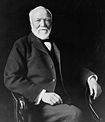
Branch Campuses Australia • Silicon Valley • QatarStudent life Traditions • Greek Life • Kiltie Band • Scotch'n'Soda • Miller Gallery • The Tartan • WRCT • University Athletic AssociationResearch Pittsburgh Supercomputing Center • Software Engineering Institute • Robotics Institute • Human Computer Interaction Institute • Language Technologies Institute • Pittsburgh Life Sciences Greenhouse • Carnegie SchoolPeople Projects and legacies Categories:- City of Pittsburgh historic designations
- Pittsburgh History & Landmarks Foundation Historic Landmarks
- Neighborhoods in Pittsburgh, Pennsylvania
- United States places with Orthodox Jewish communities
- Academic enclaves
- Economy of Pittsburgh, Pennsylvania
Wikimedia Foundation. 2010.

